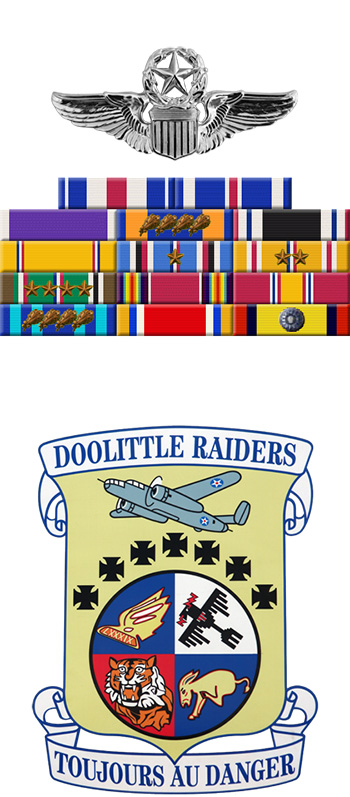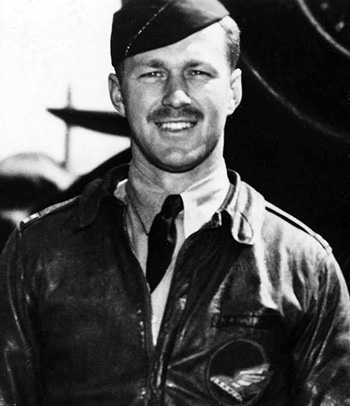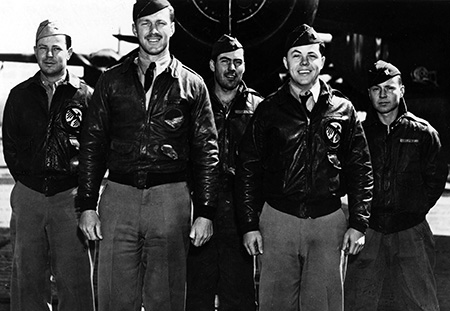
|
Charles Ross Greening |
 |
|||
| Rank, Service | ||||
Colonel O-6, U.S. Air Force |
||||
| Veteran of: | ||||
|
||||
| Tribute: | ||||
Ross Greening was born on November 12, 1914, in Carroll, Iowa. After completing his bachelor's degree at Washington State College in 1936, he enlisted in the Aviation Cadet Program of the U.S. Army Air Corps on June 23, 1936, and was commissioned a 2d Lt and awarded his pilot wings at Kelly Field, Texas, on June 30, 1937. His first assignment was as a P-6 Hawk and P-26 Peashooter pilot with the 79th Pursuit Squadron of the 20th Pursuit Group at Barksdale Field, Louisiana, from July 1937 to June 1938, followed by service as a B-18 Bolo pilot with the 11th Bomb Squadron of the 7th Bomb Group at Hamilton Field, California, from June 1938 to June 1940. Capt Greening served as a B-18 and then B-25 Mitchell pilot, as Commander of the 19th Air Base Squadron, and as Provost Marshal with the 17th Bomb Group at McChord Field, Washington, and then at Pendleton Army Airfield, Oregon, from June 1940 until he was selected for the Doolittle Mission in February 1942. Capt Greening served as the pilot on the 11th B-25 to take off from the aircraft carrier USS Hornet (CV-8) on April 18, 1942, and after bombing targets around Tokyo, Japan, the crew flew to China and bailed out when their aircraft ran out of fuel. After the raid he was promoted to Major and returned to the United States as Group Commander of the 17th Bomb Group at Columbia Army Air Base, South Carolina, and at Barksdale Field before deploying with the Group to Algeria in November 1942. Lt Col Greening served as a B-26 Marauder pilot and Commander of the 17th Bomb Group in Algeria and Tunisia until he was shot down and taken as a Prisoner of War by the Germans while flying a combat mission over Naples, Italy, on July 17, 1943. Col Greening managed to escape from captivity in September 1943, and after evading for 6 months he was recaptured in March 1944, and taken to Stalag Luft I in Barth, Germany, where he was held as a Prisoner of War until being repatriated on May 14, 1945. His next assignment was as Chief of the Army Air Forces Prisoner of War Exposition from June 1945 to September 1946, followed by service as Director of the Syndicate Division and then Chief of the Seminar Division with the Air Tactical School at Tyndall AFB, Florida, from December 1946 to August 1948. Col Greening attended Armed Forces Staff College at Norfolk, Virginia, from August 1948 to January 1949, and then served as an RB-17 Flying Fortress and RB-29 Superfortress pilot and as Director of Operations and Training for the 91st Strategic Reconnaissance Wing at McGuire AFB, New Jersey, from January to June 1949. His next assignment was as Commander of the 91st Strategic Reconnaissance Group at McGuire AFB from June to August 1949, followed by U.S. Air Force Special Staff School at Craig AFB, Alabama, from September to October 1949. Col Greening served as Chief of Special Projects, Staff Planning Officer with the Domestic Branch in the Policy Division, and as Chief of the Domestic Branch in the Policy Division with Headquarters Aeronautical Chart Service and the Deputy Chief of Staff for Operations with Headquarters U.S. Air Force in the Pentagon from November 1949 to August 1953. He attended Air War College at Maxwell AFB, Alabama, from August 1953 to August 1954, and then attended the Attaché Course with the Strategic Intelligence School in Washington, D.C., from August to November 1954. Col Greening served as Air Attaché to Australia and New Zealand from January 1955 until he was forced to return to the United States due to an illness in June 1956. He remained in a patient status at Walter Reed Army Hospital in Washington, D.C., until he died on active duty on March 29, 1957. Col Greening was buried at Arlington National Cemetery. |
||||
|
||||


